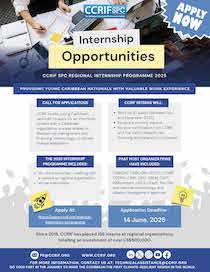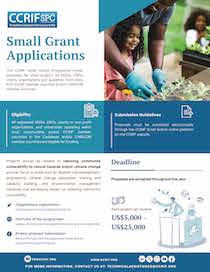Caribbean and Central American countries face a number of primary natural hazard risks, particularly earthquake and hurricane risks. Secondary risks such as those from flooding and landslides, storm surge and wave impacts, and tsunamis also pose significant threat. Additionally, these countries are frequently affected by extreme precipitation events that are often, but not always, induced by tropical cyclones.
This book provides a collection of questions and answers that provide a comprehensive overview of CCRIF and its products and services as well as its role within the wider context of disaster risk management.
CCRIF SPC offers earthquake, tropical cyclone and excess rainfall policies to Caribbean governments. In April 2015, CCRIF signed a Memorandum of Understanding with COSEFIN (the Council of Ministers of Finance of Central America, Panama and the Dominican Republic) to allow Central American countries to access similar coverage
CCRIF SPC (formerly the Caribbean Catastrophe Risk Insurance Facility) is a not-for-profit risk pooling facility, owned, operated and registered in the Caribbean for Caribbean governments. It offers parametric insurance designed to limit the financial impact of catastrophic tropical cyclones, earthquakes and excess rainfall events on Caribbean governments by quickly providing short-term liquidity when a policy is triggered.
In 2014, the facility was restructured into a segregated portfolio company (SPC) to facilitate offering new products and expansion into new geographic areas and is now named CCRIF SPC. The new structure, in which products are offered through a number of segregated portfolios, allows for total segregation of risk.
This third publication of technical papers, which focuses on work completed by recipients of CCRIF scholarships who have completed a Masters degree in areas related to disaster risk management.
This book provides answers to questions frequently asked by persons who wish to learn more about CCRIF and its products and services. It is an update to the publication, “A Guide to Understanding CCRIF – A Collection of Questions and Answers”.
Governments are often challenged with the significant task of financing recovery efforts after a disaster. Whilst dealing with the fiscal demands to undertake relief operations such as ensuring the availability of emergency assistance and sourcing funding for shelter, food and medical attention for displaced persons, governments also have to contend with the simultaneous challenge of mobilising enough resources to undertake the medium- to long-term recovery and reconstruction process.
This Report, “CCRIF – A Stakeholder Analysis” was prepared from information obtained through a Beneficiary Assessment of CCRIF undertaken by the World Bank in June 2011. The purpose of this Report “CCRIF – A Stakeholder Analysis”, commissioned by the CCRIF, is to expand on the results of the Beneficiary Assessment and to determine, based on members’ and stakeholders’ views, how to enhance the operations of the Facility to meet the needs of its members and stakeholders, whilst at the same time achieving the vision and mission of the Facility.





